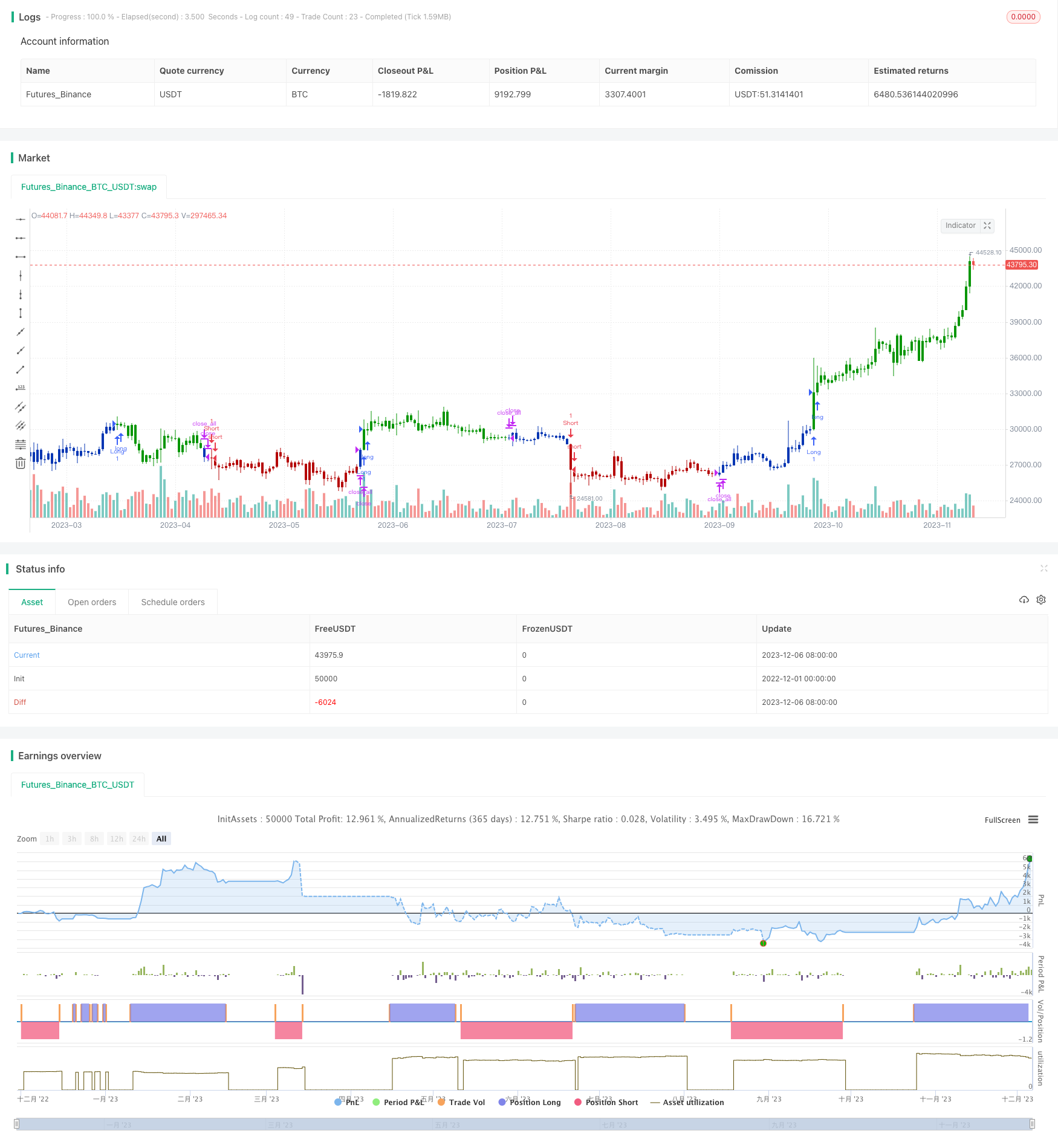
概述
该策略融合了123反转策略和未来推移均线策略,实现了当两个策略同时发出信号时进行 entrada 或 salida 的量化交易策略。该策略主要应用于股指期货市场,通过捕捉短期反转信号和中长期趋势信号的组合,实现了中短期持仓交易。
策略原理
123反转策略
123反转策略源自《我如何在期货市场上将资金翻三番》一书。该策略在连续两天收盘价出现反转时并且9日慢速K线低于50时做多;在连续两天收盘价出现反转时并且9日快速K线高于50时做空。
未来推移均线策略
未来推移均线策略(Future Lines of Demarcation,FLD)是一种基于价格波动周期性规律的趋势跟踪策略。FLD线基于价格的中值、高值或低值向未来平移约半个周期绘制,当价格线穿过FLD线时产生交易信号。
优势分析
该策略结合反转策略和趋势跟踪策略,能同时捕捉短期市场反转机会与中长期趋势走向,实现了多时间尺度的量化交易。反转策略提供了短期获利机会,趋势跟踪部分能确保整体交易方向与趋势一致,有效控制了交易风险。此外,未来推移均线的自适应特性也增强了策略的稳定性。
风险分析
该策略主要面临反转信号假突破的风险以及FLD线判断出现错误的风险。对于前者,可以通过调整参数确认反转信号,或增加其他辅助判定指标来提高判断准确率。对于后者,则需要优化参数,确保其能更准确描述市场的波段规律。此外,也需要警惕大周期趋势反转时FLD线出错的可能性。
优化方向
- 改进反转策略,增加其他指标过滤确认信号,降低假突破概率
- 对比不同FLD线参数看是否能更准确描述周期规律
- 添加止损逻辑,以控制单笔损失风险
- 测试不同品种参数效果
总结
该策略结合反转与趋势的交易理念,在中短期时间框架实现稳定盈利。未来可从确认信号准确性、描述趋势准确性、控制风险等方面进行优化,使策略参数范围更广、稳定性更强。
策略源码
/*backtest
start: 2022-12-01 00:00:00
end: 2023-12-07 00:00:00
period: 1d
basePeriod: 1h
exchanges: [{"eid":"Futures_Binance","currency":"BTC_USDT"}]
*/
//@version=4
////////////////////////////////////////////////////////////
// Copyright by HPotter v1.0 28/08/2020
// This is combo strategies for get a cumulative signal.
//
// First strategy
// This System was created from the Book "How I Tripled My Money In The
// Futures Market" by Ulf Jensen, Page 183. This is reverse type of strategies.
// The strategy buys at market, if close price is higher than the previous close
// during 2 days and the meaning of 9-days Stochastic Slow Oscillator is lower than 50.
// The strategy sells at market, if close price is lower than the previous close price
// during 2 days and the meaning of 9-days Stochastic Fast Oscillator is higher than 50.
//
// Second strategy
// An FLD is a line that is plotted on the same scale as the price and is in fact the
// price itself displaced to the right (into the future) by (approximately) half the
// wavelength of the cycle for which the FLD is plotted. There are three FLD's that can be
// plotted for each cycle:
// An FLD based on the median price.
// An FLD based on the high price.
// An FLD based on the low price.
//
// WARNING:
// - For purpose educate only
// - This script to change bars colors.
////////////////////////////////////////////////////////////
Reversal123(Length, KSmoothing, DLength, Level) =>
vFast = sma(stoch(close, high, low, Length), KSmoothing)
vSlow = sma(vFast, DLength)
pos = 0.0
pos := iff(close[2] < close[1] and close > close[1] and vFast < vSlow and vFast > Level, 1,
iff(close[2] > close[1] and close < close[1] and vFast > vSlow and vFast < Level, -1, nz(pos[1], 0)))
pos
FLD(Period,src) =>
pos = 0
pos := iff(src[Period] < close , 1,
iff(src[Period] > close, -1, nz(pos[1], 0)))
pos
strategy(title="Combo Backtest 123 Reversal & FLD's - Future Lines of Demarcation", shorttitle="Combo", overlay = true)
Length = input(15, minval=1)
KSmoothing = input(1, minval=1)
DLength = input(3, minval=1)
Level = input(50, minval=1)
//-------------------------
Period = input(title="Period", defval=40)
src = input(title="Source", type=input.source, defval=close)
reverse = input(false, title="Trade reverse")
posReversal123 = Reversal123(Length, KSmoothing, DLength, Level)
posFLD = FLD(Period,src)
pos = iff(posReversal123 == 1 and posFLD == 1 , 1,
iff(posReversal123 == -1 and posFLD == -1, -1, 0))
possig = iff(reverse and pos == 1, -1,
iff(reverse and pos == -1 , 1, pos))
if (possig == 1)
strategy.entry("Long", strategy.long)
if (possig == -1)
strategy.entry("Short", strategy.short)
if (possig == 0)
strategy.close_all()
barcolor(possig == -1 ? #b50404: possig == 1 ? #079605 : #0536b3 )